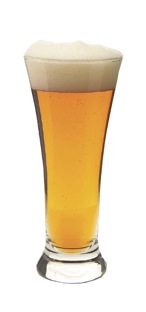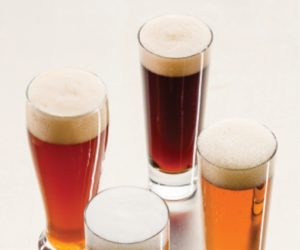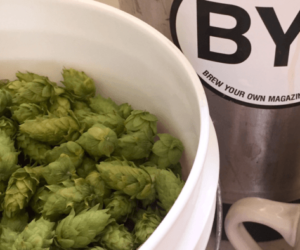Go For the Gold with Pale Beers

Hit the Target
Doing well with any homebrew in competition means brewing a beer that meets a select and widely recognized set of criteria in terms of appearance, aroma, flavor, and character. Just because you happen to have a great-tasting, light-colored beer does not mean that it will do well in competition. All recognized competitions provide a set of style guidelines as part of the entry information, and the first step in brewing a competition-winning beer is knowing the parameters for the style you want to enter. In almost every competition there will be at least one (and usually more) case in which a judge has made a note on the summary of a score sheet that says, “This is a really well made and flavorful beer, but it is not true to the style.”
The best way to ensure that a beer meets the guidelines for a particular style is to compare the listed characteristics against those of the homebrew in question. It is also helpful to purchase commercial examples of a particular style, if any are available, and try them alongside their homebrewed counterparts in a direct taste comparison. Using this combination of written descriptions and taste comparisons assures that your homebrew truly does represent the style it is supposed to.
Hitting the target with a light beer can be considerably more crucial than with a darker, heavier style, simply because there is a much narrower margin for error. A slight deviation in hopping a barleywine can be easily overlooked due to the large and complex flavor profile of the style. However, the same error in an American light pilsner can result in a glaringly out of balance beer that does poorly in judging. The lighter color, along with the more delicate malt and hop profiles often found in pale beers, make knowing and hitting the target for a style crucial due to the lack of big flavors that can many times hide small faults in balance or flavor.
Freshness Counts
Recently some of the megabreweries have begun marketing a concept that homebrewers and brewpub visitors have realized from the beginning: Fresh beer tastes better. While that prize-winning barleywine may just be reaching its peak flavor after 10 months in the bottle, a delicate bohemian pilsner will already have begun to degrade in flavor. Generally, higher gravity and aggressively hopped beers tend to hold off the effects of age the best, while those that are lighter in color and flavor tend to degrade the quickest.
Does this mean that all is lost when the next competition is eight months down the road and your Dortmunder pils is tasting great? Not at all. There are a few tricks that can help stave off the effects of age on homebrew.
First, when selecting the ingredients for a light beer, use the freshest available. Questionable hops of dubious condition or unknown alpha-acid values are an invitation to disaster in any beer, especially one in which the hop/malt balance is delicate.
Also, try to avoid the super-high-alpha bittering hops, going instead with a low- or medium-alpha variety. While at first it may seem strange to use Yakima Hallertauer with an alpha acid level of 3.6 percent as a bittering hop, doing so allows the brewer a much greater margin for error without having a detrimental effect on the balance of the finished product. This is true because many of the lighter ales and lagers have a very low bitterness level.
In a beer such as an American lager, a high-alpha bittering hop variety with an alpha-acid level of 10 percent or higher may require as little as one-eighth to one-half ounce of hops to meet the bitterness requirements for the style. If the final volume of the beer turns out to be slightly higher or lower than the projected volume or if the measurement of the hops was off by as little as just a few pellets, the result could be a dramatically out of balance beer. For a lower alpha acid hop variety, the bittering requirements for the same style of beer can be as much as 1.5 to two ounces of hops. The result is that slight variances in volume or in the measuring of the hops will have a less significant overall impact on the finished product.
Also, most listed alpha-acid values on hops are averages for a crop or batch, and within each sample there can exist some variation. Using a very small amount of a high-alpha hop to bitter a light lager means a variation of as little a 0.1 percent in alpha acid can substantially alter the final bittering values in the beer. The same variation in a low-alpha variety will not have quite as dramatic an impact on the overall amount of hops required for the same recipe.
In making an exceptionally light-colored beer, this is one area where all-grain brewers have an advantage over their malt extract counterparts. The process of making malt extract requires a drying or dehydration process. When the extract is concentrated into syrup or powder form, some darkening takes place. Also, as malt extracts age they tend to darken slightly in color due to a natural reaction, much the same way a sliced apple will turn dark if left to sit on the counter for a few hours.
This is something that can create havoc when the final homebrew is supposed to be the color of light straw. Watch for freshness dating on the can or package. Also, avoid using bulk syrups if they are dispensed from the drum over time without a protective blanket of nitrogen or CO2 gas to displace the malt as it is dispensed. Excess exposure to oxygen will also serve to slightly darken syrup malt extracts.
With grains, use the freshest available and avoid using pre-crushed malts if they are more than just a week or so old. Bargain-basement grains or crushed grain that is several weeks old can result in stale flavors that even in very mild levels will upset the balance of a crisp, light beer.
With yeast, try to stick to fresh liquid yeast cultures to help ensure a healthy, vigorous fermentation that will be less likely to exhibit any unusual flavors or aromas that would be extremely obvious in a light beer. For lagers, true liquid yeast strains fermented at the recommended temperatures are virtually a must to obtain the clean, finished product the judges will be looking for. Allow lagers an adequate time to develop the clean character of the finished beer. A short fermentation or one at an incorrect temperature can result in aromas and flavors that no judge can fail to notice in what is otherwise meant to be a mild, clean beer.
Freshness is not limited strictly to the ingredients and raw materials. The two biggest enemies to the flavor of a well-made, finished pale homebrew are oxygen and heat. After fermentation use care any time that you are transferring or bottling to avoid splashing or aerating the beer. Minimize headspace and do everything possible to avoid introducing additional oxygen into the finished beer.
While it is not possible to eliminate all of the oxygen from the finished product, very small amounts will speed up the staling process and bring on a flavor that many times judges will describe as “cardboardy” or “sherrylike.”
While being able to refrigerate the entire finished batch would be optimum, simply keeping the finished bottles as cool as possible in a basement or dark closet will greatly extend the period of time that the beer will be at its peak flavor.
Adjuncts Are Okay
One of the major effects of the homebrewing revolution was to reintroduce everyone to the positive benefits associated with making all-malt beers. As a result, in the last decade homebrewing has come a long way from when it was commonplace to make a batch of homebrew by using very little malt extract and adding enormous amounts of sugar to make up the difference. But most of the beers produced in America today that epitomize light lagers and ales use some form of adjunct in their recipes. This is because proper use of adjuncts such as rice and corn is one of the key ways to help produce exceptionally light, crisp beers with a delicate body and flavor.
Generally, as long as the adjunct does not make up more than 10 percent of the total fermentables in the recipe, the finished beer will not suffer any of those cidery, winey, headachy characteristics often associated with Prohibition-style homebrew. These off-flavors usually result from following old recipes when it was not uncommon to use as much or more sugar in a recipe than malt.
There are many different types of adjuncts that can be used, and all will help to lighten the color, body, and flavor of the finished beer while still contributing to the fermentable gravity. All-grain brewers can try adding cooked rice or flaked corn into the mash, while any brewer can use corn syrup, rice syrup, corn sugar, or dry rice solids directly into the boil to achieve the same result.
All of these ingredients will boost the starting gravity of the beer, yet they provide very little additional color compared with adding the same amount of barley malt. The excellent fermentability of adjuncts means they will ferment out clean, leaving a crisp, dry character with very little residual flavor that would be noticed in a paler style of beer such as American standard lager.
When using adjuncts in an all-grain mash, try incorporating some six-row barley in the recipe. Six-row barley has a very high level of diastatic power, meaning that it is rich in the enzymes needed to convert starches into sugars in the mash. Adjuncts usually are lacking in enzymes, and the use of a small amount of six-row barley, one to two pounds in a five-gallon batch, will help ensure adequate conversion of all of the additional starches.
The 30-Minute Boil
The one-hour boil has pretty much become standard in homebrewing for many reasons. A strong, 60-minute boil provides good hop utilization, helps drive out sulfur compounds that would affect the finished beer, and ensures a microbially clean environment for the yeast to do its work during the fermentation phase. Unfortunately, during extended boils some caramelization of sugars takes place. As a result, the finished beer will darken slightly, working against the brewer trying to make a prize-winning pale lager or ale.
Reducing the boil time to 30 minutes reduces the darkening effect, but a few additional things must be taken into consideration. Primarily, the risk of ending up with a hazy beer increases significantly because too many proteins may be left in the wort after the boil. You may also end up with a large amount of sediment in the bottle.
A short boil does not mean a mild one; the boil must still be vigorous to ensure that compounds such as dimethyl sulfide (DMS) do not adversely affect the finished beer. Do not reduce the boil time below 30 minutes, because you still need to ensure adequate pasteurization of the wort before the fermentation phase. Needless to say, avoid at all costs scorching the wort onto the bottom of the brewpot. Scorching is easy to do when using an electric stove or one of the mega-BTU outdoor cookers, and the result will be not only a darker beer but also one with a smoky or burnt flavor as well.
The biggest adjustments in using a shorter boil center on hop utilization. This is where good notes on previous batches will help. Exact figures for hop utilization efficiency vary depending on each brewer, his equipment, wort gravity, procedures, and other factors. For a starting point figure that you will have to multiply the hops used in a 60-minute boil by 1.6 to calculate the increased amount needed for the shorter 30-minute boil. This should get you in the ballpark. Make other adjustments based on your experiences.
A Clear Winner
Clarity is one of the most striking visual characteristics of a well made light golden beer and the one many judges notice first. There are a number of steps that can be taken to ensure a finished beer that has the brilliant clarity necessary to bring home the gold. A strong boil followed by proper wort chilling is essential and not just for good sanitation. A strong boil and quick chilling help to coagulate and drop out of suspension the proteins that will contribute to chill hazes in the finished beer. Two-stage fermentation is strongly advised. Fining agents such as Irish moss in the boil and gelatin in the fermenters will help to drop additional particulates out of suspension.
Advanced brewers who have kegging systems can go even further by using any one of the many small homebrew filter systems that are available today to remove all of the yeast from the beer, followed by artificial carbonation and counterpressure bottling.
This will result in a competition beer that is entirely free of any sediment in the bottles. All other factors of balance and flavor being equal, when two light or pale beers are up against each other in competition the judges will most likely be predisposed, even subconsciously, in favor of the crystal-clear beer.
And the Winner Is…
While many of the ideas presented here may be new or unusual to some brewers, more often than not the winner in many homebrew competitions didn’t resort to any one magical ingredient or trick, just good common sense and sound brewing practices. Meticulous attention to details of sanitation and brewing theory is what separates the consistent winners from the “also brewed.”


